Nonwoven is a fabric-like material made from staple fiber, long fibers, or both bonded together by chemical, mechanical, heat, or solvent treatment. According to ISO standard 9092 and CEN EN 29092, a nonwoven is an engineered fibrous assembly, primarily planar, given a designed level of structural integrity by physical and chemical means, excluding weaving, knitting, or paper-making. The nonwoven fabrics offer extra-ordinary properties, which diversify their applications from simple packaging materials to high-tech applications, i.e., medical, healthcare, filtration, construction, personal care, automotive, electronics, and more.
 European Disposables and Nonwovens Association (EDANA) identified that the most significant growth areas for nonwovens in 2020 were observed in medical (+118.0%) and wipes/personal wipes (+22.0%) followed by garments (+32.6 %). According to figures collected and compiled by the EDANA secretariat, production of nonwovens in Greater Europe grew by 7.2% in 2020 to reach 3,075,615 tonnes (and 85.9 billion square meters) with a total estimated turnover of €9,555 million. The total output of the 27 European Union countries is now over 2.15 million tonnes, which suggests the potential of the nonwoven market. The “Nonwoven Fabric Market – Forecast (2020 – 2025)” report highlights that the segment is going to improve further and reach $42 billion by 2025, after growing at a CAGR of 7.4% during 2020-2025, owing to the vast usage of nonwoven fabrics in various applications. There have been many developments in the nonwoven industries. The developments include both manufacturing aspects and finishing or product development aspects. However, much of the innovations have been from machine manufacturers.
European Disposables and Nonwovens Association (EDANA) identified that the most significant growth areas for nonwovens in 2020 were observed in medical (+118.0%) and wipes/personal wipes (+22.0%) followed by garments (+32.6 %). According to figures collected and compiled by the EDANA secretariat, production of nonwovens in Greater Europe grew by 7.2% in 2020 to reach 3,075,615 tonnes (and 85.9 billion square meters) with a total estimated turnover of €9,555 million. The total output of the 27 European Union countries is now over 2.15 million tonnes, which suggests the potential of the nonwoven market. The “Nonwoven Fabric Market – Forecast (2020 – 2025)” report highlights that the segment is going to improve further and reach $42 billion by 2025, after growing at a CAGR of 7.4% during 2020-2025, owing to the vast usage of nonwoven fabrics in various applications. There have been many developments in the nonwoven industries. The developments include both manufacturing aspects and finishing or product development aspects. However, much of the innovations have been from machine manufacturers.
INDEX™ is one of the most prominent global meeting places for the nonwovens market. INDEXTM takes place once every three years and provides a unique opportunity to explore the nonwoven industry’s latest innovations and connect with like-minded professionals. INDEX™ 20 will take place in Geneva from 19 – 22 October 2021. INDEX™ event will display all the latest developed technologies related to the nonwoven industry. The event will include the following cutting-edge developments from various nonwoven machine manufacturers:
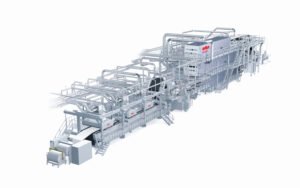 Oerlikon Nonwoven
Oerlikon Nonwoven
Oerlikon is an engineering company with a wide range of nonwoven technologies. The company provides stand-alone machines and turnkey production lines for almost every type of nonwoven product. At INDEX™20, Oerlikon nonwoven will showcase its latest developments focusing on the market- and customer-oriented system solutions for filtration, hygiene, medical, geotextile, and other industrial applications. The key highlights to explore at INDEX™20 include:
• Airlaid technology The Oerlikon Nonwoven airlaid process is ideal for processing pulp or cellulose fibers raw material into high-end products for a wide range of applications. The patented Oerlikon Nonwoven formation process sets standards for homogeneous fiber laying and superb evenness for nonwovens with low running meter weights. Furthermore, it permits the homogeneous mixing of the most diverse raw materials, including pulp, short- and long-staple natural and manmade fibers (up to 20 mm) and powders, as well as the utilization and combination of the most diverse mechanical, thermal and chemical tangling methods for creating the requisite product properties.
• Meltblown technology: Oerlikon meltblown offers unique and highly sophisticated nonwovens for filtration, insulation, and sorption applications. It distinguishes itself from other concepts currently available on the market as a result of its extreme flexibility. The polymers used to produce the filter media and membranes are as diverse as their applications. The spectrum ranges from classical polyolefins (PP, PE), PET, PLA, PBT, and PA all the way through to special plastics such as PPS and TPU. All these and other raw materials can be reliably processed using the Oerlikon Nonwoven meltblown procedures. In addition, the ecuTEC+ electro-charging unit electrostatically charges filter media in order to increase filter efficiency further. Users can choose from numerous possible variations and set the optimum charge intensity for their respective filter applications.
• Spunbond technology: Oerlikon Spunbond systems are capable of high production capacities and yields with simultaneously low energy consumption. To this end, geotextiles made from polypropylene or polyester can be efficiently manufactured with running meter weights of up to 400 g/m2 and filament titers of up to 9 dtex. Oerlikon Nonwoven also offers specialized spunbond processes for producing nonwoven substrates for roofing underlays (PP or PET spunbonds) and so-called bitumen roofing substrates (needled PET spunbonds) for bitumen roofing membranes.
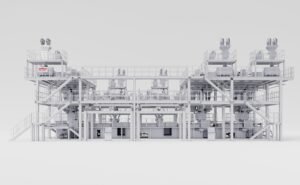 • QSR spunmelt technology: QSR (Quality Sized Right) technology for hygiene applications offers a financially attractive solution for producing this highly diverse spunbond and meltblown composites (SSMMS, SMMS, and SSS) by globally accepted standards. Oerlikon Nonwoven can equip a unique system with unique features that enable producers to distinguish themselves within their respective markets with unique nonwoven properties such as higher volumes, softness, and customer-specific embossed patterns, for example.
• QSR spunmelt technology: QSR (Quality Sized Right) technology for hygiene applications offers a financially attractive solution for producing this highly diverse spunbond and meltblown composites (SSMMS, SMMS, and SSS) by globally accepted standards. Oerlikon Nonwoven can equip a unique system with unique features that enable producers to distinguish themselves within their respective markets with unique nonwoven properties such as higher volumes, softness, and customer-specific embossed patterns, for example.
• Phantom technology: Oerlikon Nonwoven offers an alternative technology for manufacturing various wet wipes from pulp and polymer fibers. Here, the spunmelt and airlaid processes are combined to perfectly unites the properties of the starting materials. The material mix can comprise up to 90% cellulose fibers. Alternatively, cotton or synthetic fibers can also be added. Compared to processes such as classical spunlace (hydroentangled carded nonwovens) produced to date, the Phantom technology offers ecological, performance, and cost advantages. Dispensing with hydroentanglement renders subsequent drying of the material redundant.
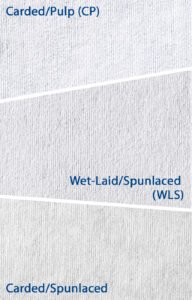 Trutzchler Nonwoven
Trutzchler Nonwoven
Trutzchler was established in 1888. The German company stands for competence in fiber preparation. The company is known for its innovation and technology in the nonwoven area. At INDEXTM 20, Trutzhler nonwoven will be introducing:
• Wet-laid/spunlaced technology: Truetzschler Nonwovens and Voith will address the quest for more sustainable and affordable nonwovens in the wipes segment by two proven technologies for manufacturing pulp-based nonwovens. Firstly, WLS (Wet-Laid/Spunlaced) lines. More than a handful are in service worldwide and mainly target the flushable wipes market. At INDEXTM, Trutzcher will introduce the latest nextLevel/WLS baby and body wipes, a joint development by Voith and Truetzschler.
• Carded/pulp (CP) products: The second focus is on carded/pulp (CP) products. A CP line – including a TWF-NCT card placed between the HydroFormer and the AquaJet is already running to total capacity at the customer site. Various CP materials, including innovative nextLevel/CP wipes, will be displayed at the booth and invite visitors to discuss characteristics, benefits, line concepts, and equipment.
• The Z wire for high-speed roller cards: Truetzschler card clothing will present its latest development, the Z wire for high-speed roller cards. A new geometry minimizes fiber fly and allows for better carding and more stable web forming.
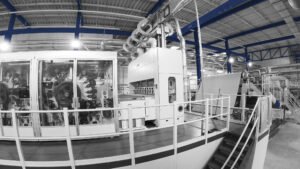 Bruckner Nonwovens
Bruckner Nonwovens
Bruckner has collaborated with Sonovia for the sono-chemical finishing of nonwovens. The one-step, the sono-chemical finishing process is suitable for all types of textiles, whether made from natural fibers like cotton, linen, silk, synthetic materials, or a blend of both. The procedure uses zinc-oxide nanoparticles as an active medium and is based on the physical phenomenon of acoustic cavitation. The technology provides optimum antimicrobial and antiviral properties with durability. At Bruckner Textile Technologies’ technology center, relevant tests will be carried out starting in the second quarter of 2021. V-Jet is the latest technology by Swiss Autefa Solutions. With V-Jet Futura, the company recently sealed the link between web forming and drying technology in its product range. This latest hydroentanglement machine, together with the SQ-V square drum dryer, embodies advanced technology combined with significant reductions in energy consumption compared to other process solutions.
DILO Group
DILO Group is the leading equipment supplier of complete lines for staple fiber nonwoven fabric production. At INDEXTM 20, DILO nonwoven will be introducing:
• Hyperpunch technology: Hyperpunch HαV technology allows a more uniform stitch distribution in the preneedling process, especially in combination with the new needle pattern 6000X. In a complete needling line, this felt homogenization process can be improved further by using the new needle pattern 8000X, which is a milestone in the needle pattern development process and results in endproduct surfaces with low markings over a wide range of advances/stroke.
• 3D-Lofter technology: The “3D-Lofter,” presented during ITMA 2019 in Barcelona, offers a broader range of nonwovens applications by exploring the third dimension. A series of single web forming units which work according to the aerodynamic web forming principle deliver defined fiber masses in varied patterns on a base needlefelt. A stress-oriented production of technically formed parts resulting in fiber savings or patterned DI-LOUR or DI-LOOP felts are two examples of this technology exploring new application areas for needlefelts.
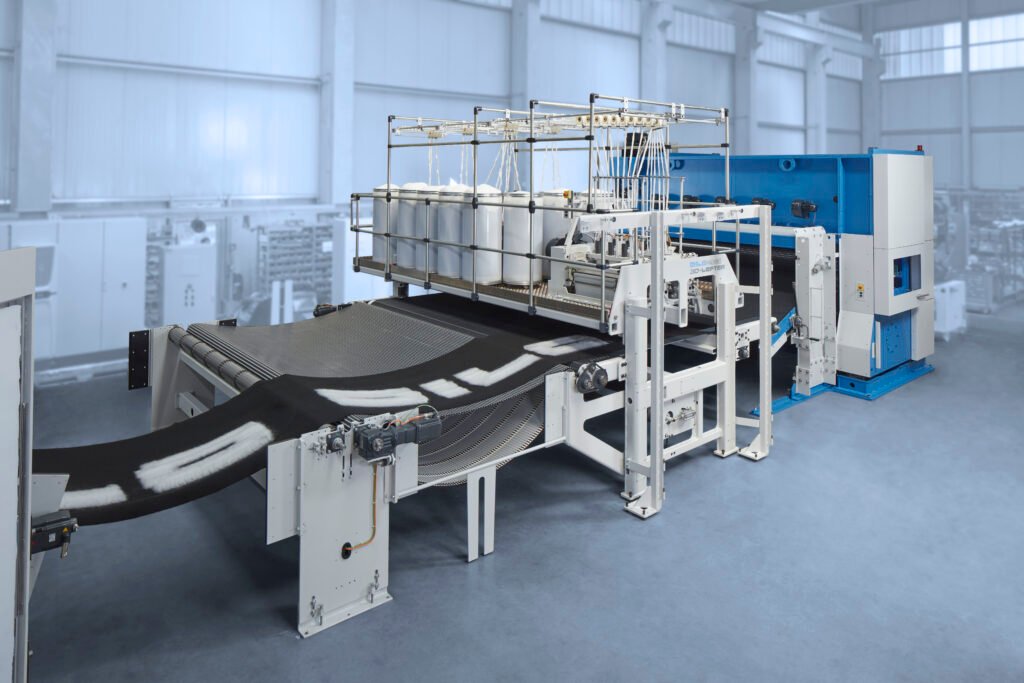 Andritz Nonwoven is an Austria-based nonwoven company that has recently shown its neXline wet lace CP technology. The company also offers technology for producing biodegradable and sustainable nonwovens. Using the neXline wet lace CP, natural fibers such as viscose or pulp can be processed smoothly to produce a high-performance and cost-efficient carded-pulp wipe that is fully biodegradable.
Andritz Nonwoven is an Austria-based nonwoven company that has recently shown its neXline wet lace CP technology. The company also offers technology for producing biodegradable and sustainable nonwovens. Using the neXline wet lace CP, natural fibers such as viscose or pulp can be processed smoothly to produce a high-performance and cost-efficient carded-pulp wipe that is fully biodegradable.
Reifenhauser nonwoven is a German company known for its innovative technologies related to the nonwoven sector. Though the company has various nonwoven fabrication lines, the meltblown line is the focus of the hour due to the COVID-19 pandemic. The company’s single-row meltblown technology provides an optimum barrier and filtration properties. The polymer is spun through a spinneret provided with several thousand holes in a single row. Streams of hot air exiting at both sides of the spinneret tip attenuate the polymer melt to form ultra-fine filaments that are then blown by high-velocity air onto a collector screen. This results in a meltblown fabric with excellent barrier and filtration properties. At the same time, the multirow meltblown technology offers perfect elasticity and absorption properties. The polymer melt is spun through a spinneret provided with up to 14 rows of fine nozzles. The filaments are blown horizontally onto a drum or vertically onto the collector screen. This results in a meltblown fabric with extremely high elasticity and good absorption properties.
Research is extensively carried out on nonwoven fabrics to extend their applications. Researchers at the University of Georgia have developed a nonwovens cotton composite that is stretchable, breathable, and absorbent, reportedly superior to materials currently used to fabricate face masks, bandages, and similar medical products. The cotton nonwoven produced showed that the composite fabrics had improved water absorbency compared to the original nonwoven while maintaining good breathability. The water absorption of the composites was three to 10 times higher compared with the cotton-free fabric. The composite materials also maintained the ability of nonwovens to recover from being stretched, allowing them to accommodate spontaneous movements without losing their shape.
Another company, Fibroline, based in Limonest, France, has developed a portfolio of advanced technologies for achieving the thorough integration of dry functional powders into or onto the surface of fabrics or yarns via a high voltage generator and an alternating electric field. The nonwoven fabrics have many spaces inside their structure which could provide the opportunity to add different functional dry powders making these nonwovens technologically advanced. Fibroline will present its latest developments at the INDEX 2020 Smart Nonwovens sector seminar, which will occur on October 20th, 2021, during the show in Geneva, which runs from October 19-22. Some of the highlights of the developments by Fibroline are the Fibroline D-Preg system to replace latex binders and enable recycling in the manufacture of nonwoven carpets for exhibitions. Other companies employ D-Preg technology to remove VOCs, odors, and glass fibers from automotive headliners and add binders to flax nonwovens to produce composites.
Ease, a home cleaning brand, has launched nonwoven sheets made of natural fibers with the ability to allows whites and colored clothes to wash together while preventing color bleeds and extra fabric dyes from reaching the water source. Ease’s robust laundry detergent sheets eliminate toxic ingredients and can catch harmful chemicals. The nonwoven detergent sheets are eco-friendly and safe to the skin; it is free of paraben, allergen, and bleach.
INDA and EDANA have released the 2021 edition of standard procedures for the nonwoven industries. These Nonwovens Standard Procedures help define the industry, with specifiers for its properties, composition, and specifications. Offering harmonized language for the industry across the USA and Europe and recognized by many other individual markets, the procedures offer a way for the nonwovens industry to communicate across the globe and within the supply chain to ensure that product properties can be consistently described, produced, and tested.



